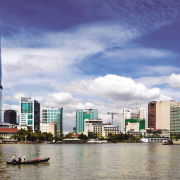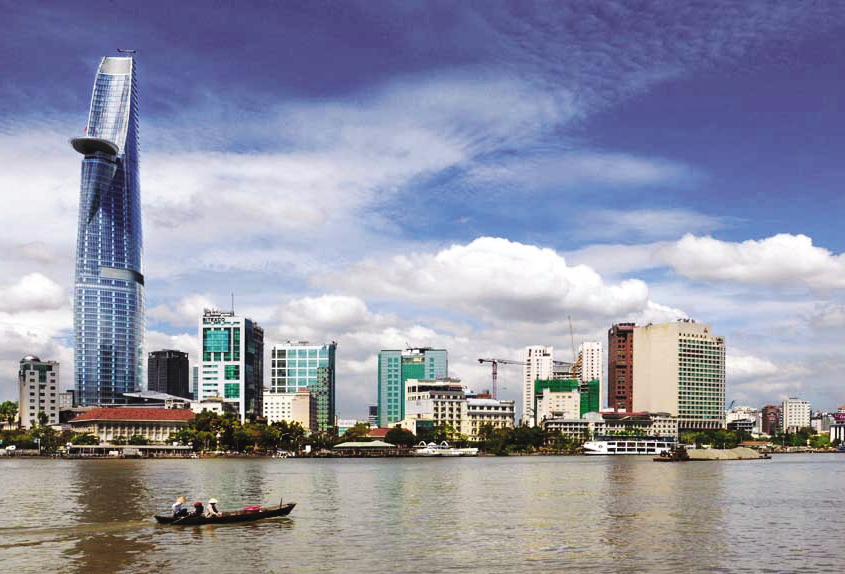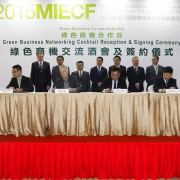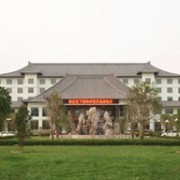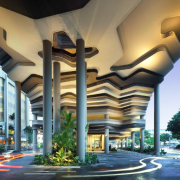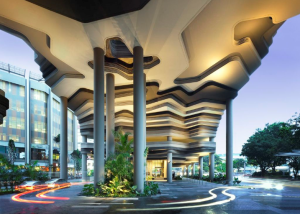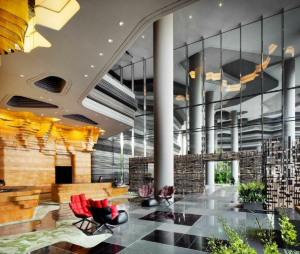A peek into Vietnam’s green adoption
A recently published white paper titled “Is There a Future for Green Buildings in Vietnam?” assesses the current market overview of Vietnam’s green building industry. The document was released by Solidiance – an Asia-focused B2B management consultancy firm – in partnership with Vietnam Green Building Council (VGBC).
According to the paper, the green buildings market in Vietnam is still at the early stages of development, primarily as a result of cost sensitivities, low electricity prices, short-term thinking and misaligned incentives between building developers and users, an underdeveloped regulatory market, and a limited supply of skilled employees with green building awareness.
At present, there are only approximately 40 buildings that have achieved a green building certification in Vietnam. These are concentrated in the industrial sector, initiatives driven by global corporate guidelines, Corporate Social Responsibility (CSR), and the need to reduce operating expenses. However, office buildings and the hospitality sector are also seeing increased green building adoption as property developers seek to attract premium rates and stand out in crowded markets. The residential segment has been lagging on low awareness and short-term cost considerations, though certain technologies such as solar water heaters have taken off.
What drives green initiatives in Vietnam?
Global corporate guidelines are leading many multinationals to go green. This is the case with Big C’s Green Square store in southern Binh Duong province, as well many industrial facilities.
Sales & marketing strategies for offices and residential buildings to enhance brand value, increase occupancy rates, and ultimately attract premium rental fees. President Place, the first LEED gold office building in Vietnam, was opened in 2012 in Ho Chi Minh City, aiming to capitalize on its status as first in market.
Cost savings aimed at reducing operating expenses by building users, especially for energy costs. The need to reduce energy costs will increase in urgency and importance as Vietnam’s government continues to move towards market-based pricing of power, resulting in price hikes.
Low supply of high-grade buildings a chance for green buildings to carve out a niche and attract those companies looking for superior office space to what is currently on the market.
What are the barriers stalling the development of green building?
Low electricity prices relative to the rest of Southeast Asia is a disincentive to promoting energy efficiency. The government is planning to raise electricity prices but tariff hikes have been gradual to limit the impact on inflation, production, and low-income consumers.
Limited skills availability in the market as universities and training institutions are only beginning to address the topic of green buildings.
Short-term thinking and misaligned incentives by property developers focused on short-term costs rather than long-term savings available to building users.
Lack of government incentives has not provided property developers with the short-term benefits needed to drive green building adoption.
Low awareness and price-sensitivity among domestic companies that tend to work with local suppliers without green building materials or technologies, as leading suppliers of green buildings materials and technologies are typically multinational corporations who work primarily with international developers.
Current two primary green certification that is currently used in Vietnam
Property developers in Vietnam have two primary choices when aiming for green building certification: LEED and LOTUS. LEED was developed by the U.S. Green Building Council (USGBC) and is recognized around the world as a leading ratings tool. LOTUS is based on the same principles as other green buildings ratings tools including LEED but it was developed to fit Vietnam’s climate, infrastructure, regulations, and level of economic development in order to increase its relevance to the local market.
At present, there are more LEED-certified buildings in Vietnam but the first pilot set of criteria for LOTUS was only introduced in 2010. With support from VGBC and due to its local relevance, LOTUS will continue to gain in prominence in Vietnam.
Cost and Benefits of Going Green in Vietnam
Short term costs: A primary barrier to green building adoption is short-term cost considerations and the perception that going green is markedly more expensive than not doing so. But is it really that much more expensive to go green? As LOTUS certification has yet to become widely adopted, data on implementation costs are not yet available. However, experience from implementation in other tropical areas shows that the cost premium for going green is anywhere from 1-10% that of a normal building. With local suppliers of green building materials and technologies still limited in Vietnam, the costs might prove higher in the short-term but as demand for such products increases, supply will rise, and costs will drop.
Long term gains: Payback on investment will happen with lower operating costs as well as increased rental income and potentially higher occupancy rates for green office buildings and hotels. Lower operating costs come primarily in the form of lower electricity bills, with efficient air-conditioners, low-energy lights, and energy-efficient glass each providing anywhere from 5-10% energy savings. In addition to hard monetary savings, a greener building that provides natural light, improved air quality and access to green space has been demonstrated to improve employee productivity and lower absentee rates.
Developing a skilled workforce to build green
For the green buildings industry to take off, green building industry leaders with the required skills need to emerge. Developing these skills at Vietnam’s universities will be key to promoting green buildings.
A handful of universities and training centres have responded to the small, but, growing market demand by offering green architecture and energy-saving classes, as well as hosting urban development and energy-saving conferences through partnership with foreign universities.
The private sector is also involved in green initiatives. For example, Holcim promotes green and sustainable practices in Vietnam by holding a competition for universities students annually. The challenge is to develop green and sustainable ideas. The jury votes and Holcim finances the best ideas into reality.
The Vietnam green building Council (VGBC), key to skills development in Vietnam, began offering LOTUS training in June 2011 with its LOTUS Accredited Professional course and Green Buildings Basics. Interest in LOTUS training courses has mainly been concentrated in Ho Chi Minh City, which registers 3x more participants than Hanoi.
How is Vietnam’s regulatory environment impacting green building development?
While economic development has been the primary focus of policymakers, the government has begun to put regulations in place designed to promote energy efficient buildings and define a green buildings development road map. During the period of 2005-2012, a series of laws were passed to promote energy efficiency.
What is needed to further boost the industry is clear and attractive incentives for developers to build green, possibly including preferential and fast-track approvals process for new building permits, as well as the establishment of green building standards in public buildings, which would help raise awareness and drive demand for green building materials and technologies.
How can industry players, Government agencies, civil society, and multilaterals boost the industry in Vietnam?
Industry players can…
• Generate demand by raising awareness, promoting showcase projects, and most importantly, demonstrating return on investment.
• Develop and promote products and technologies that are suitable to Vietnam’s environment and market.
• Partner with other leading multinationals to offer integrated and complementary green buildings solutions.
• Get involved through Vietnam Green Building Council (VGBC), EuroCham’s GreenBiz Working Group, and other industry associations to advise the government on regulatory reform, promote best practices, and build a network of like-minded professionals.
• Support universities and advise them on the development of a green building curriculum, as well as offer internships to students to give them practical, on-the-ground experience in the industry.
Government agencies can…
• Implement incentives for developers to build green
• Establish green building standards for public buildings
• Define a green buildings development road map, following the release of the Green Growth Strategy
• Carrot and stick approach – in addition to offering incentives, provide clear punishments for those violating green buildings regulations and regularly enforce
Vietnam Green Building Council can…
• Train people who work in sustainable construction (architects, project managers, suppliers)
• Develop green buildings network, raise awareness in Vietnam
• Advocate and advise policymakers
Multilateral agencies can…
• Initiate and finance trainings on green buildings and LOTUS through Vietnam’s NGO network
• Offer technical advice to government ministries to improve the regulatory environment
Source: Is There a Future for Green Buildings in Vietnam? (white paper by Solidiance & VGBC)
Link : http://www.solidiance.com/whitepaper/is-there-a-future-for-green-buildings-in-vietnam.pdf
This article was published in Building Review Journal vol 29 no. 1. For more market insights and White Papers, please visit Solidiance.

